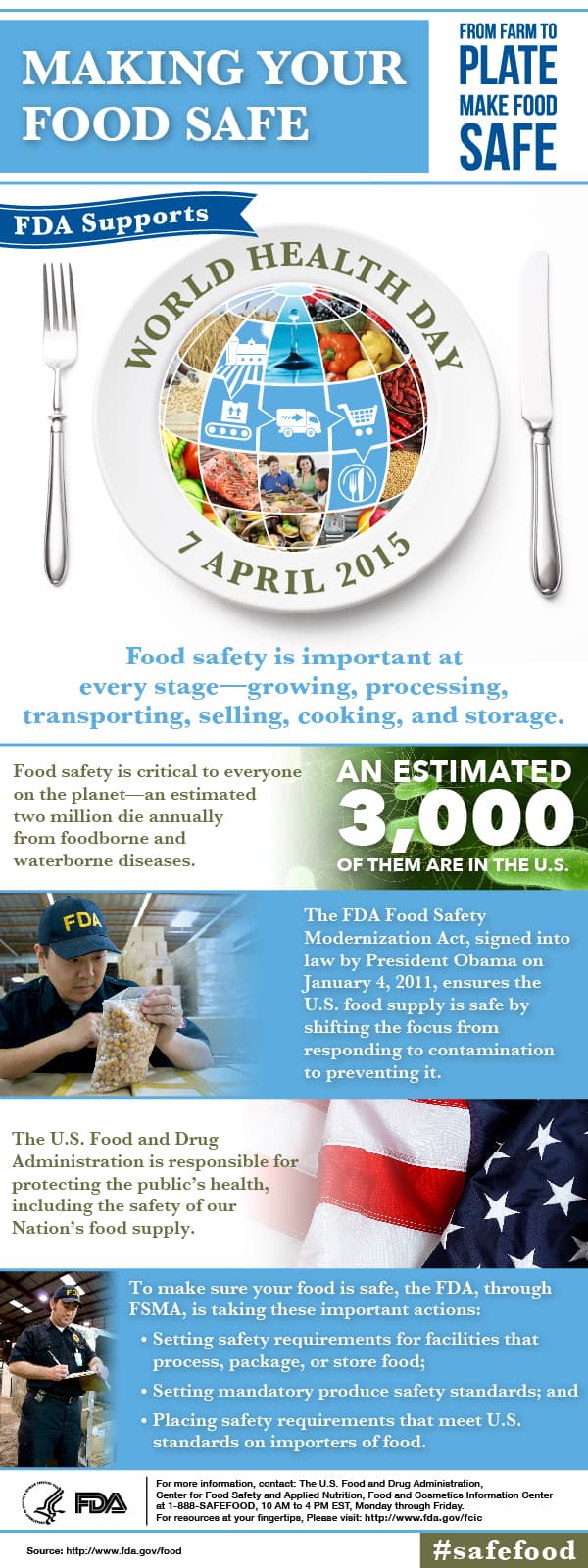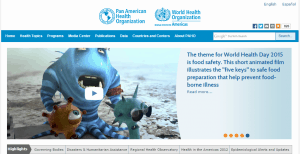Organizations unite for interactive World Health Day event
The Pan American Health Organization/World Health Organization (PAHO/WHO) and the United Nations Foundation educated people about important food safety issues with their World Health Day #FoodSafety+Social Good webcast. The interactive event allowed people to ask questions and get answers on Facebook and Twitter using the hashtags #FoodSafety and #SocialGood.
The goal of the event was to engage a new audience around the world in dialogue about food safety. What amazing work to engage people online for World Health Day!
Cooperative Extension Educators use Meat Models to Promote Food Safety Awareness
Rachel Parsons, a Nutrition Educator at Cornell Cooperative Extension Broome shared her favorite food safety education activity below with us for World Health Day 2015.
Many of my participants don’t understand food may have gone bad even though it doesn’t look or smell any different. Bacterial cells are microscopic, so we can’t even see that they are there. At Cooperative Extension we bring awareness to participants by using meat models made out of common materials that closely resemble ground beef.
We use lentils to represent bacteria cells, so that participants can “see” what normally they can’t see. The first model represents our starting point; it is safe to assume there are some bacteria present in with raw meat so the first one starts out with 3 (lentils) “bacteria”. Bacteria cells reproduce quickly and at room temperatures they double every 20 minutes. The scenario I commonly use is grocery shopping, the moment we took that meat package out of the case it starts warming up to room temperature and our “clock” starts. Our next model shows 6 bacteria at 20 minutes. The next model has 12 bacteria at 40 minutes. And then after an hour, there are 24 bacteria.
Throughout a series of lessons I encourage participants to look at labels, compare pricing, and take their time in the store– but that timer keeps running and the bacteria keep multiplying!. After two hours our 3 starting bacteria have multiplied to 192 cells, and it only takes one to make us sick! Our last model shows that after 3 hours there are more than 1000 bacteria cells present. That package might not look or smell any different but that growth is happening and making that food unsafe to eat.
Participants are encouraged to think of other times this bacterial growth can happen (dairy foods left out, cut fruits and vegetables, “doggie bag delay”, thawing at room temperature, picnics, etc.). We also encourage participants to think of ways they can protect their families (purchasing meat and refrigerated products last, bringing a cooler, limit other stops when shopping, safe ways to thaw meat, etc.).
I also share that the two hour limit is reduced to one hour when temperatures are very high, bacterial growth is more rapid at higher temperatures. This use of models really helps participants understand why the two hour rule is so important in food safety. Our participants share that they learned the most from and that it led them to change their behavior.
New App Helps Consumers Keep Food Safe
To support World Health Day 2015, the USDA is launching a new food safety application designed to help consumers maintain the freshness and quality of foods. The FoodKeeper application offers users valuable storage advice about nearly 500 food and beverage items, including various types of baby food, dairy products and eggs, meat, poultry, produce, seafood, and more. Every year, billions of pounds of good food go to waste in the U.S. because consumers are not sure of its quality or safety.
Food waste from households represents about 44% of all food waste generated in the U.S. It is estimated that 20 pounds of food is wasted per person per month. This application will help users maintain the freshness and quality of the foods in their home. It can show them how to store foods properly and reminds users to use items before they are likely to spoil.
For safe (and fresh!) food, check out the FoodKeeper App today!
World Health Day Letter from the Executive Director
Shelley Feist, Executive Director of the Partnership for Food Safety Education, discusses World Health Day 2015.
The World Health Day has set aside April 7 to focus on food safety from farm to plate— the theme of World Health Day 2015. WHO says the day focuses on “demonstrating the importance of food safety along the whole length of the food chain in a globalized world, from production and transport, to preparation and consumption.”
For its’ part, the non-profit Partnership for Food Safety Education will be working through social media on April 7 to recognize and pay tribute to the thousands of health and food safety educators, teachers, and community leaders, that work to teach consumers about the importance of safe food handling to reducing risk of illness – especially for young children and other vulnerable populations.
WHO’s 10 Facts on Food Safety include that “everybody has a role to play in keeping food safe”, (Fact 9) and “consumers should be well informed on food safety practices,” (Fact 10). These are two important facts that sometimes get pushed down in priority when the food industry is focusing on production, transport, and sales of food. But these two facts are the basis for the work of the Partnership and its network of BAC Fighters in the United States.
And we agree with WHO’s statement that “People should make informed and wise food choices and adopt adequate behaviors. They should know common food hazards and how to handle food safely, using the information provided in food labelling.” But as any consumer knows, labels on food might give you some of the steps to keeping food safe (it might give you the safe end-point temperature, for example), but protecting one’s health includes preparing for handling food by first washing hands thoroughly with soap and running water whenever possible; using a food thermometer to measure if food has reached a safe temperature –not guessing based on whether it looks hot; and being aware of how actions at home might spread harmful bacteria from a raw food to a surface or to hands, and other methods of cross-contamination.
In the United States consumers benefit from a required meat and poultry safe handling label. Consumers should always take notice of the label, and encourage children to read the label with them when they prepare these products. For the full range of simple but critical steps to reducing risk of foodborne illness, consumers should turn to Clean, Separate, Cook and Chill, and to fightbac.org as a source to be informed about and involved as active partners in the food safety chain of prevention.




